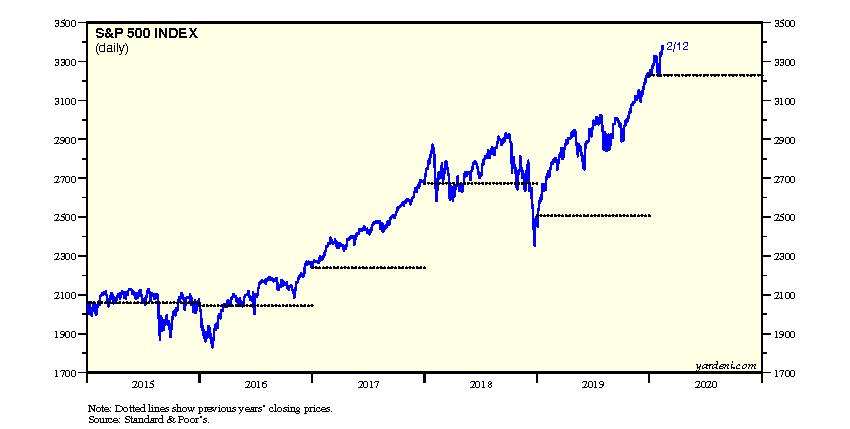
I discussed the possibility of a meltup in stock prices in my 12/18/19 Morning Briefing titled “2020 Vision.” I wrote:
“Another risk is that investors could conclude that there is nothing to fear but fear itself. That could lead to a meltup. When the S&P 500 rose to our 3100 target for this year on 11/15, we started to consider the possibility of a meltup scenario involving an advance to our 3500 year-end 2020 target well ahead of schedule in early 2020. We may be experiencing that meltup now given that the S&P 500 is getting close to 3200 already!”
I reiterated this view in my first commentary of 2020, dated 1/6 and titled “Nothing to Fear But Nothing to Fear (and Iran).” As it turned out, the crisis with Iran didn’t last long enough to merit adding it to our Table of S&P 500 Panic Attacks Since 2009. However, we did add the coronavirus outbreak as #66 on our list with a 1/24 date, when the outbreak news first hit the tape. So far, it has turned out to be among the very short and minor selloffs, as theS&P 500 dropped only 3.0% from 1/23 through 1/31 (Fig. 1). The index is up 4.6% YTD, closing at a new record high of 3379.45 on Wednesday. A gain of just 3.6% would put it at our 3500 target for year-end!
That’s quite a remarkable development. Recall that there were a couple of panic attacks in 2018 and again in 2019 triggered by Trump’s escalating trade war with China (Fig. 2 and Fig. 3). One of the big worries was that the trade frictions would disrupt supply chains and force companies to spend money to move them out of China. It seems to me that the coronavirus outbreak in China poses a more immediate and greater threat to supply chains. Yet here we are at record highs in the S&P 500, DJIA, and NASDAQ.
There was also a minor panic attack when the yield curve inverted last summer (Fig. 4). But the Fed reversed that problem by cutting the federal funds rate for a second and then a third time last year on 9/18 and 10/30. The yield curve since has flattened again and may be about to invert again too. Yet this story is getting no play in the financial press as a pressing concern about an imminent recession the way it did last year.
The markets must figure that the coronavirus outbreak will be contained soon and go into remission, as did SARS, MERS, and Ebola. If that doesn’t happen, then there will be a vaccine that will make us feel better. It won’t be a miracle cure coming from a drug company. Rather, it will be injections of more liquidity into the global financial markets by the major central banks.
On Tuesday, Fed Chair Jerome Powell implied that the Fed is on standby to do just that. In his testimony on monetary policy to Congress, he said:
“Some of the uncertainties around trade have diminished recently, but risks to the outlook remain. In particular, we are closely monitoring the emergence of the coronavirus, which could lead to disruptions in China that spill over to the rest of the global economy.”
Meanwhile, I continue to monitor the weekly fundamental indicators for the S&P 500 for signs of the viral infection:
(1) Forward revenues and earnings: It’s too soon to tell whether the virus outbreak is starting to weigh on S&P 500 revenues and earnings. S&P 500 forward revenues remained at a record high during the 1/30 week. Forward earnings edged down 0.3% during the 2/6 week from its $179.01 record a week earlier (Fig. 5). The forward profit margin remained at 12.0% during the 1/30 week.
(2) Q1-Q4 earnings: Nevertheless, industry analysts may have just started to cut their Q1-Q3 earnings estimates during the 2/6 week to reflect the possible negative consequences of the virus on the companies they follow (Fig. 6). They seem to be doing their best to offset those cuts by boosting their Q4 estimates, by which time the virus problem should have passed, in their collective estimation.
